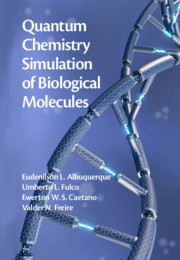Book contents
- Frontmatter
- Contents
- Preface
- Figure Credits
- 1 Basic Properties of Quantum Chemistry
- 2 Charge Transport in the DNA Molecule
- 3 Electronic Transmission Spectra of the DNA Molecule
- 4 Thermodynamic Properties of the DNA Molecule
- 5 Properties of the DNA/RNA Nucleobases
- 6 Molecular Electronics
- 7 Amino Acid Anhydrous Crystals
- 8 Protein–Protein Systems
- 9 Ascorbic Acid and Ibuprofen Drugs
- 10 Cholesterol-Lowering Drugs
- 11 Collagen-Based Biomaterials
- 12 Antimigraine Drugs
- 13 Antiparkinson Drugs
- 14 Central Nervous System Disorders
- 15 The Biology of Cancer
- 16 Concluding Remarks
- Bibliography
- Index
3 - Electronic Transmission Spectra of the DNA Molecule
Published online by Cambridge University Press: 21 January 2021
- Frontmatter
- Contents
- Preface
- Figure Credits
- 1 Basic Properties of Quantum Chemistry
- 2 Charge Transport in the DNA Molecule
- 3 Electronic Transmission Spectra of the DNA Molecule
- 4 Thermodynamic Properties of the DNA Molecule
- 5 Properties of the DNA/RNA Nucleobases
- 6 Molecular Electronics
- 7 Amino Acid Anhydrous Crystals
- 8 Protein–Protein Systems
- 9 Ascorbic Acid and Ibuprofen Drugs
- 10 Cholesterol-Lowering Drugs
- 11 Collagen-Based Biomaterials
- 12 Antimigraine Drugs
- 13 Antiparkinson Drugs
- 14 Central Nervous System Disorders
- 15 The Biology of Cancer
- 16 Concluding Remarks
- Bibliography
- Index
Summary
We present a model describing the electrical conductivity and the current–voltage (IxV) characteristics along DNA finite segments within a tight-binding Hamiltonian model. To mimic the DNA molecule, we consider first a dangling backbone ladder (DBL)-DNA Poly(CG) sequences, whose building blocks are the bases cytosine and guanine. We found that the long-range (short-range) character of the correlations is important to the transmissivity spectra (IxV curves). Afterward, we investigate a Poly(CG-CT) DNA segment with diluted base pairing restricted to occur at a fraction p of the cytosine nucleotides, at which a guanine nucleotide is attached. We show that the effective disorder introduced by the diluted base pairing is much stronger in poly(CG) than in poly(CT) segments, with significant consequences for the electronic transport properties. Finally, methylated DNA strands sandwiched between two metallic electrodes are considered, whose IxV curves suggest potential applications in the development of novel biosensors for molecular diagnostics.
Keywords
- Type
- Chapter
- Information
- Quantum Chemistry Simulation of Biological Molecules , pp. 60 - 88Publisher: Cambridge University PressPrint publication year: 2021



